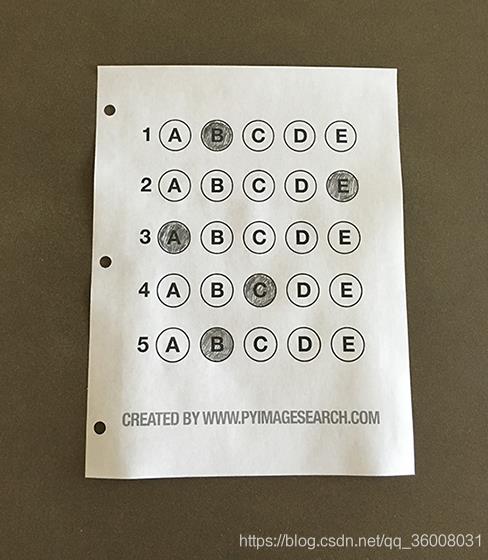本文实例为大家分享了opencv实现答题卡识别的具体代码,供大家参考,具体内容如下
"""
识别答题卡
"""
import cv2
import numpy as np
def showImg(img_name, img):
cv2.imshow(img_name, img)
cv2.waitKey()
cv2.destroyAllWindows()
def get_max_rect(sorted_cnts):
for cnt in sorted_cnts:
# 轮廓近似
possible_cnts = []
epsilon = 0.1 * cv2.arcLength(cnt, True)
approx = cv2.approxPolyDP(cnt, epsilon, True)
if len(approx) == 4:
possible_cnts.append(cnt)
possible_cnts = sorted(possible_cnts, key=lambda x: cv2.arcLength(x, True))
return possible_cnts
def get_max_bounding_rect(possible_cnts):
# for cnt in possible_cnts:
# x, y, w, h = cv2.boundingRect(cnt)
sorted_cnts = sorted(possible_cnts, key=lambda cnt: cv2.boundingRect(cnt)[2]*cv2.boundingRect(cnt)[3], reverse=True)
print(sorted_cnts[0])
def show_countour(img, cnt):
img_copy = img.copy()
cv2.drawContours(img_copy, cnt, -1, (0,255, 0), 3)
showImg("img_copy", img_copy)
# 读取答题卡图片,并显示
answer_sheet_img = cv2.imread("t1.jpg")
print(answer_sheet_img.shape)
showImg("answer_sheet_img", answer_sheet_img)
# 高斯滤波,去除噪音
blur = cv2.GaussianBlur(answer_sheet_img,(5,5),0)
showImg("blur", blur)
# 图像转灰度值
sheet_gray = cv2.cvtColor(blur, cv2.COLOR_BGR2GRAY)
showImg("sheet_gray", sheet_gray)
# 二值化
retval, sheet_threshold = cv2.threshold(sheet_gray,177, 255, cv2.THRESH_BINARY)
# print(type(sheet_threshold), sheet_threshold)
showImg("sheet_threshold", sheet_threshold)
# 边界检测
edges = cv2.Canny(sheet_threshold, 100, 200)
showImg("edges", edges)
# print(type(edges))
# 寻找轮廓
copy_edges = edges.copy()
img_copy = answer_sheet_img.copy()
img, cnts, hierarchy = cv2.findContours(copy_edges, cv2.RETR_TREE, cv2.CHAIN_APPROX_SIMPLE)
cv2.drawContours(img_copy, cnts, -1, (0,0,255), 1)
showImg("img_copy", img_copy)
# 对所有轮廓加一个外接矩形,找最大的外接矩形
max_area_index = None
area = 0
for index, cnt in enumerate(cnts):
x, y, w, h = cv2.boundingRect(cnt)
if w*h > area:
max_area_index = index
show_countour(answer_sheet_img, cnts[max_area_index])
# 仿射,拿到答题卡主要部位
x, y, w, h = cv2.boundingRect(cnts[max_area_index]) # 最大的边界
cv2.rectangle(answer_sheet_img, (x, y),(x+w, y+h), (0,0,255), 2)
showImg("answer_sheet_img", answer_sheet_img)
pts1 = np.float32([[x,y], [x+w, y], [x+w, y+h]])
pts2 = np.float32([[0,0], [w, 0], [w, h]])
M = cv2.getAffineTransform(pts1, pts2)
sheet_threshold_copy = sheet_threshold.copy()
dst = cv2.warpAffine(sheet_threshold_copy, M, (w, h))
showImg("dst", dst)
print(answer_sheet_img.shape)
part_sheet_img = answer_sheet_img[y:y+h, x:x+w]
showImg("part_sheet_img", part_sheet_img)
# 对答案区域灰度,二值,找轮廓
part_answer_gray = cv2.cvtColor(part_sheet_img, cv2.COLOR_BGR2GRAY) # 灰度
ret, threshold_answer = cv2.threshold(part_answer_gray, 175, 255, cv2.THRESH_BINARY)
showImg("threshold_answer", threshold_answer)
img, answer_cnts, x = cv2.findContours(threshold_answer, cv2.RETR_TREE, cv2.CHAIN_APPROX_SIMPLE)
part_sheet_img_copy = part_sheet_img.copy()
cv2.drawContours(part_sheet_img_copy, answer_cnts, -1, (0, 0, 255), 1)
showImg("dst_copy", part_sheet_img_copy)
# 对所有轮廓找外接矩形,想过滤掉不合适的矩形
print("画矩形")
answer_filter_cnts = []
answer_circles = []
img_ = part_sheet_img.copy()
for cnt in answer_cnts:
x, y, w, h = cv2.boundingRect(cnt)
if 30 30:
set_num += 1
mask_dict[set_num].append(circle)
else:
mask_dict[set_num].append(circle)
print("mask_dict", mask_dict)
for k, mask_circle_list in mask_dict.items(): # 对每一个题目,保留五个答案,多余的舍去
if len(mask_circle_list) == 5:
sorted_x_mask_circle_list = sorted(mask_circle_list, key=lambda x:x[0])
mask_dict[k]=sorted_x_mask_circle_list
else:
sorted_x_mask_circle_list = sorted(mask_circle_list, key=lambda x: x[0])
sorted_x_mask_circle_list_5 = []
for i, c in enumerate(sorted_x_mask_circle_list):
if i == 0:
sorted_x_mask_circle_list_5.append(c)
else:
if abs(c[0] - sorted_x_mask_circle_list[i-1][0]) < 10:
pass
else:
sorted_x_mask_circle_list_5.append(c)
mask_dict[k] = sorted_x_mask_circle_list_5
print("mask_dict", mask_dict)
# mask_dict 分好组的按照顺序的圈圈
# 做掩码
mask_img = np.zeros_like(part_sheet_img, dtype='uint8') # 全黑图
showImg("threshold_answer", threshold_answer)
threshold_answer = np.array(threshold_answer)
# mask_dict = sorted(mask_dict, key=lambda x: mask_dict.keys())
all_scores = [] # 所有答案处的评分
for exercise_num, circle_mask_list in mask_dict.items():
# 对于每一题
score_list = [] # 每一题的每个选项的评分,涂黑的为选择的,值越接近0, 评分较低
for circle_mask in circle_mask_list:
mask_img_copy = cv2.cvtColor(mask_img, cv2.COLOR_BGR2GRAY)
# 做一个当前圆的掩码:
cv2.circle(mask_img_copy, (circle_mask[0], circle_mask[1]), circle_mask[2], (255, 255, 255), -1)
print(threshold_answer.shape, mask_img_copy.shape)
mask_img_ = cv2.bitwise_and(threshold_answer, threshold_answer, mask=mask_img_copy)
score = mask_img_.sum()
score_list.append(score)
# showImg("mask_img_", mask_img_)
all_scores.append(score_list)
all_score_np = np.array(all_scores)
s = np.argmin(all_score_np, axis=1) # 找评分最低处即为选择项
answer_dict = {
0: "A",
1: "B",
2: "C",
3: "D",
4: "E"
}
for index, v in enumerate(s):
print("第%s题的答案是%s" %(index+1, answer_dict[v]))
效果图:
以上就是本文的全部内容,希望对大家的学习有所帮助,也希望大家多多支持脚本之家。
